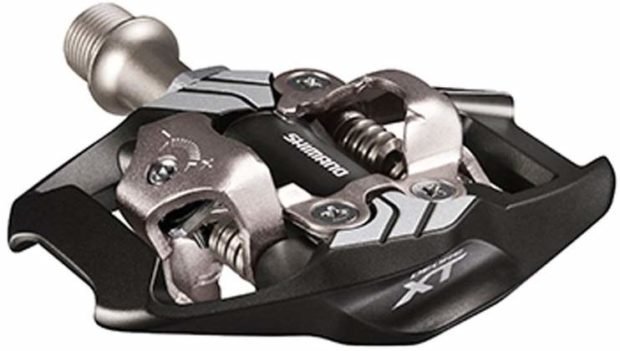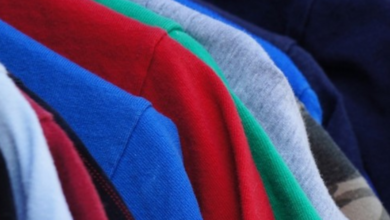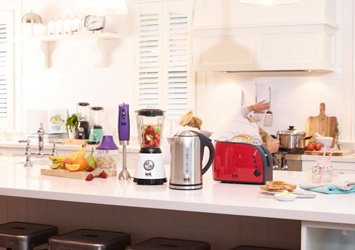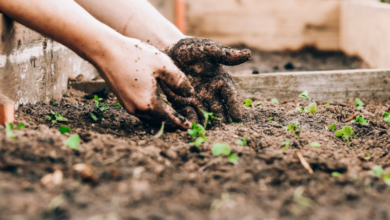Mountain Biking at 50: To Clip In or Not to Clip In, That is the Question
If you’re more the downhill or trials sort, this probably isn’t a real question for you. You want flat pedals and good hard shoes, but there is no way you’re going to have your shoe “stuck” on the pedals. For cross country riders/racers, it’s not quite as simple a decision.
What are Clipless Pedals
“Clipping in” refers to clipless pedals – I know, counter-intuitive. Clipless pedals are what came after the old toe clips/straps – hence “clipless.”
The pedal has a binding that mates to cleats on the bottom of bike shoes. The cleat/binding mechanism works similarly to ski bindings where you push the nose of the cleat in first, then put weight on the rear of the cleat to seat it.

To release your shoe/foot from the binding, you just turn your foot slightly outward and the binding releases. They will also release during a crash – I have personally confirmed this more than once.
There are alternate cleats that will release just from pulling up, but that kind of defeats one of the major advantages of clipping in.
Why Would Anyone Want to Use Clipless Pedals?
Three words: efficiency, safety, bike handling.
Clipless Pedals are More Efficient and Lighter
By clipping in, your shoe and pedal work as if they are a single unit. Because your shoe can only clip in at the foot position you set, you will always have your foot located on the pedal at its most optimal position.
Because you can also pull up on the pedal using your hamstrings and lower abs in the back half of the stroke so that you produce power during the full pedal stroke and bring another powerful set of muscles into the fight against rolling resistance, drag, and gravity.
Good flat pedal shoes, like my 510 Freerider Contacts, are heavy. The soles are the contact with the pedal so they need to not flex during the downstroke but be grippy to hold on to the pedal pins on rough sections. That additional weight is also part of your rotating mass which is the most expensive to overcome.
Clipless Pedals are Safer
The first time I cased a double (landed on top of the landing instead of the downslope side), my foot slipped off of the right pedal which promptly rotated backward and slammed into my shin yielding the ever-dreaded “pedal bite.” This is nearly impossible with clipless pedals.
Wet conditions can also make flat pedals slippery which can lead to less-efficient power transfer and increase the danger of slipping off a pedal.
Clipless Pedals Amplify Your Bike Handling Skills
First, learn basic bike handling skills using flat pedals. It will make you a better mountain biker and will allow you to drop a foot to the ground when you mess up.
With that out of the way, once you can bunny hop, track stand, handle slow speed turning and move your rear wheel side to side at slow speed, add in clipless pedals and it will magnify the skills you have already developed by allowing you to negatively load the bike. With flat pedals, you can turn the pedals down at the toe and pull up a bit to get some negative loading to raise your rear wheel when needed. With clipless pedals you can do the same but use even more force without worrying about coming off the pedals.
What to Consider in Choosing a Clipless Pedal
Two major considerations led me to my current set of Shimano Deore XT M8020 SPD Trail Pedals. I wanted to be able to clip in from either side of the pedal and I wanted a design that wouldn’t cake up with dirt and mud during a ride.

Being able to clip in on both sides of the pedals means that I can drop a foot if I need to and then clip back in without having to first spin the pedal so that the binding is on top.
The M8020’s open design allows dirt and mud to wash or drop out during rides and makes it very easy to clean afterward. Get yours HERE.
Should I Start with Clipless Pedals
The answer to this is an emphatic NO. Start with flat pedals that have good pins for traction, like these RaceFace Chester pedals, and a good pair of flat mountain biking shoes, like the Five Ten Freeriders I mentioned earlier.

Use this setup until you can properly lift your front wheel without jerking up on the handlebars, lift the rear wheel without using the front brake to “endo”, handle extremely slow speed turns, correctly bunny hop, and do a track stand. These are the basic bike handling skills every mountain biker should have in their arsenal.
Once you have those skills down, adding in clipless pedals will force you to attain another skill – getting unclipped. Everyone has a story about that time they forgot to unclip before stopping the bike or unclipping one foot then the bike wanting to dismount you on the other side. The way to avoid this is to practice unclipping.
Find a soft grassy area and clip one foot in and out over and over and over and over. Then do the other foot while the first foot stays on the ground to hold the bike steady. Then, clip in your strong-side foot, start the bike moving, clip in the other foot while moving slowly, then practice unclipping one foot, leaning your weight to the unclipped foot side and getting the foot down before the bike falls over. The weight shift is important and can be exaggerated by pushing your unclipped foot further away from the bike.
If you struggle to get unclipped by twisting, you can consider switching to a set of “easy out” cleats. These allow you to unclip by pulling up on the pedal. It will also negate the power advantage a clipless system gives you. You can find the Shimano easy off cleats HERE.
Only once you can confidently clip in and out without falling over should you consider using clipless pedals on the trails.




